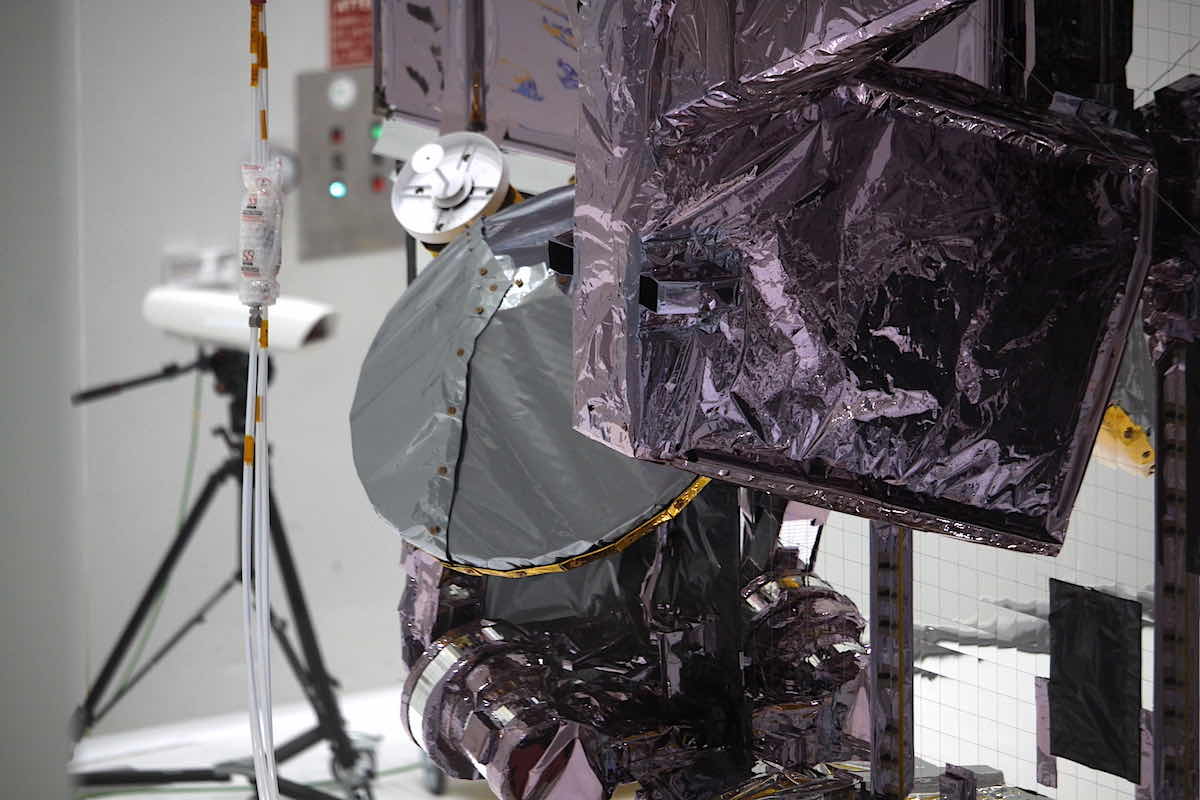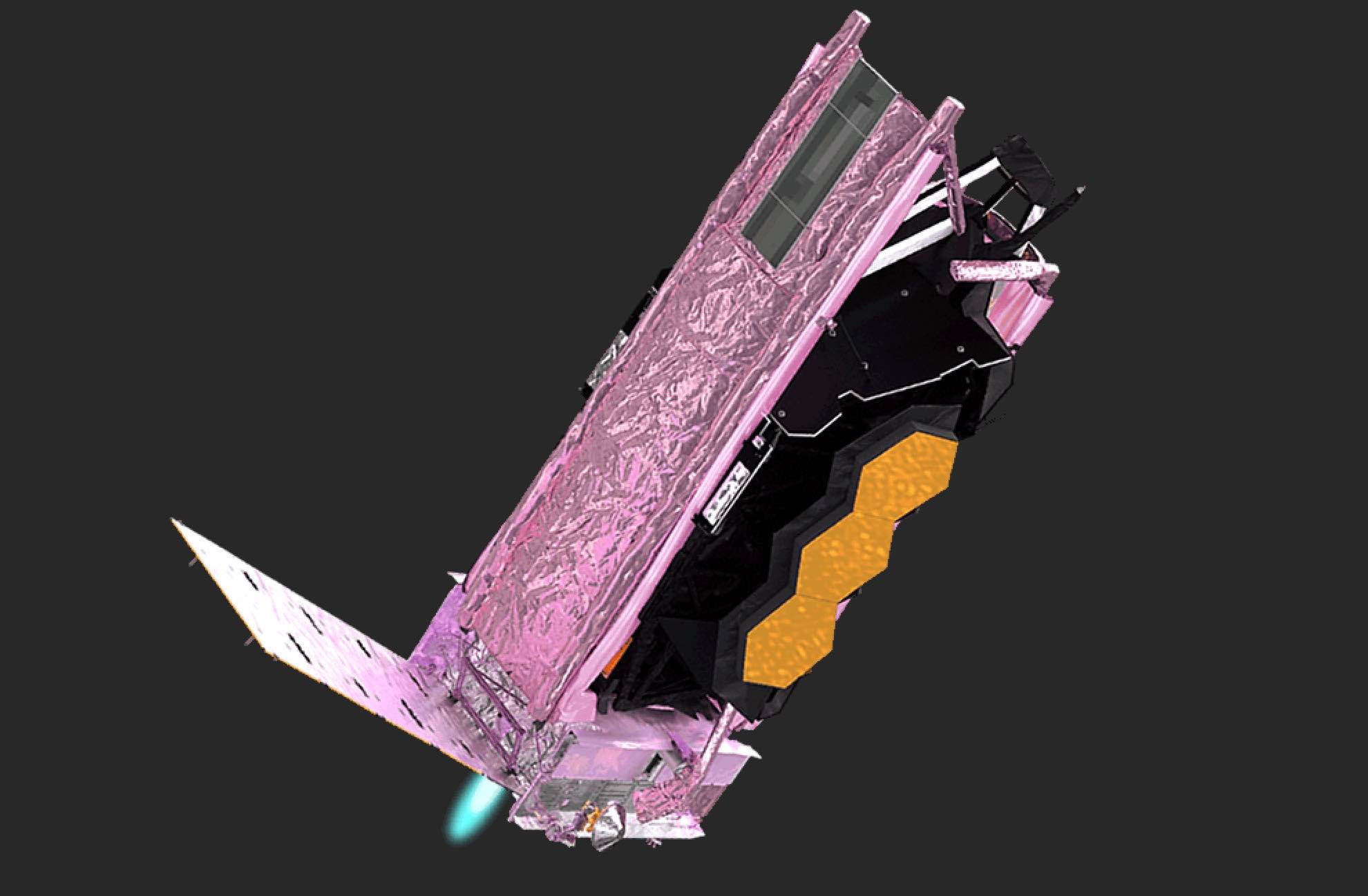
The James Webb Space Telescope fired its rocket thrusters for the first time late Saturday to line up for course toward an observing post nearly a million miles from Earth, then deployed a high-rate communications antenna Sunday to transmit science data to the ground.
The milestones were the first major events for Webb since its successful launch Christmas morning aboard a European Ariane 5 rocket from French Guiana. The Ariane 5 placed the 13,584-pound (6,161-kilogram) observatory right on target on a course into deep space, with Webb in stretched, or elliptical, orbit with an apogee, or high point, more than a million kilometers (600,000 miles) from Earth.
After deploying its solar array and priming its propulsion system following separation from the Ariane 5 upper stage, the spacecraft fired one of its main thrusters beginning at 7:50 p.m. EST Saturday (0050 GMT Sunday) for the mission’s Mid Course Correction 1a, or MCC 1a, maneuver.
The Ariane 5 rocket aimed to deploy the nearly $10 billion observatory at a velocity just shy of the speed required to reach the L2 Lagrange point, a gravitationally-neutral spot nearly a million miles (1.5 million kilometers) from Earth, four times farther than the moon’s orbit.
The launch trajectory was selected to ensure Webb could make up the speed required to enter orbit around the L2 Lagrange point, rather than needing to turn around to use its thrusters for a braking maneuver. A burn to slow down would force Webb to point its sensitive optics toward the sun, risking damage.
The Ariane 5 rocket placed Webb almost exactly on its planned course into deep space, according to officials from NASA and the European Space Agency, which supplied the launch vehicle as part of its contribution to the mission.
Webb fired one of its four hydrazine-fueled Secondary Combustion Augmented Thrusters, or SCATs, for 65 minutes Saturday night, making up nearly all of the expected velocity shortfall needed to reach an orbit around the L2 Lagrange point.
Another burn, named MCC 1b, is penciled in the Webb flight plan Monday night. Keith Parrish, Webb’s commissioning manager at NASA, said before the launch that the MCC 1b burn might not be required, depending on the trajectory analysis following the MCC 1a maneuver.
Webb controllers at the Space Telescope Science Institute in Baltimore, Maryland, perform ranging measurements with the spacecraft using radio signals passed between Webb and ground stations around the world. The data gives engineers information about Webb’s location and speed, allowing navigators to plot future trajectory correction maneuvers. In some cases, they might not be needed, Parrish said.
Another mid-course correction burn, designated MCC 2, is planned 29 days after launch — around Jan. 23 — to inject Webb into its halo orbit around L2.
Webb has four main SCAT engines. One redundant pair is used for the MCC 1a and 1b burns, while the other redundant set is used the MCC 2 maneuver and all subsequent stationkeeping burns to keep Webb in its orbit around L2 during its science mission.
Sixteen smaller thrusters, divided into eight thruster modules each with two engines, are used for pointing control and to offload momentum from the observatory’s six spinning reaction wheels, which steer Webb toward its science targets. The reaction wheels were activated soon after Webb’s launch Saturday.

With the MCC 1a burn out of the way, Webb deployed its high-rate communications antenna shortly after 10 a.m. EST (1500 GMT) Sunday, according to NASA.
The Gimbaled Antenna Assembly, or GAA, includes Webb’s 2-foot-diameter (60-centimeter) high-gain dish antenna. The Ka-band antenna will be used to transmit at least 28.6 Gbytes of science data down from the observatory, twice per day, NASA said.
Ground teams released and tested the motion of the antenna during Sunday’s deployment activity.
Before the release of the Ka-band antenna, Webb communicated to ground teams using a broad-beam S-band antenna at lower data rates. The Ka-band high-gain antenna can downlink data at a speed of up to 3.5 Mbytes per second.
Other steps completed on Webb’s first full day in space included the switch-on of temperature sensors and strain gauges on the telescope, used for monitoring Webb’s thermal and structural parameters, NASA said.
The antenna release and first mid-course correction burn set the stage for the next step of Webb’s post-launch commissioning — the deployment and tensioning of the observatory’s tennis court-sized sunshield.
The five-layer thermal barrier will keep Webb’s telescope and instruments in permanent shade, allowing the optics and detectors to reach a temperature of minus 388 degrees Fahrenheit, or 40 degrees above absolute zero. The super-cold temperatures are necessary for Webb’s infrared instruments to detect faint infrared light from the distant universe.
Two pallets containing the sunshield membranes will fold down from their launch position as soon as Tuesday, if controllers stay on the pre-planned flight schedule. That will allow for the release and tensioning of the sunshield this weekend.
Two wings holding six of Webb’s 18 hexagonal primary mirror segments are expected to fold into place in early January, building the shape of the observatory’s 21.3-foot-diameter (6.5-meter) optical surface. Then comes additional steps to align the mirror and bring it into focus, all while engineers turn on and test each fo Webb’s four science instruments.
But Webb’s time-sensitive commissioning steps — the solar array deployment and first course correction burn — are now complete. Teams have more flexibility in scheduling the remaining commissioning steps over the next six months, culminating in the release of the first science images some time in mid-2022.
Email the author.
Follow Stephen Clark on Twitter: @StephenClark1.
